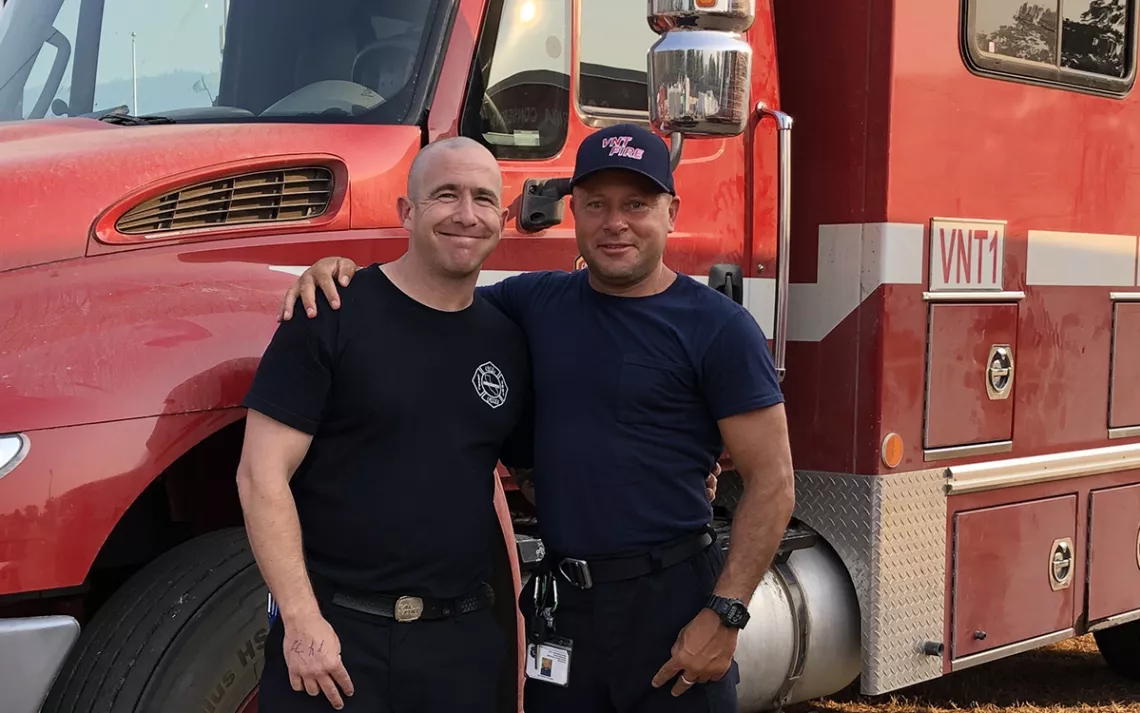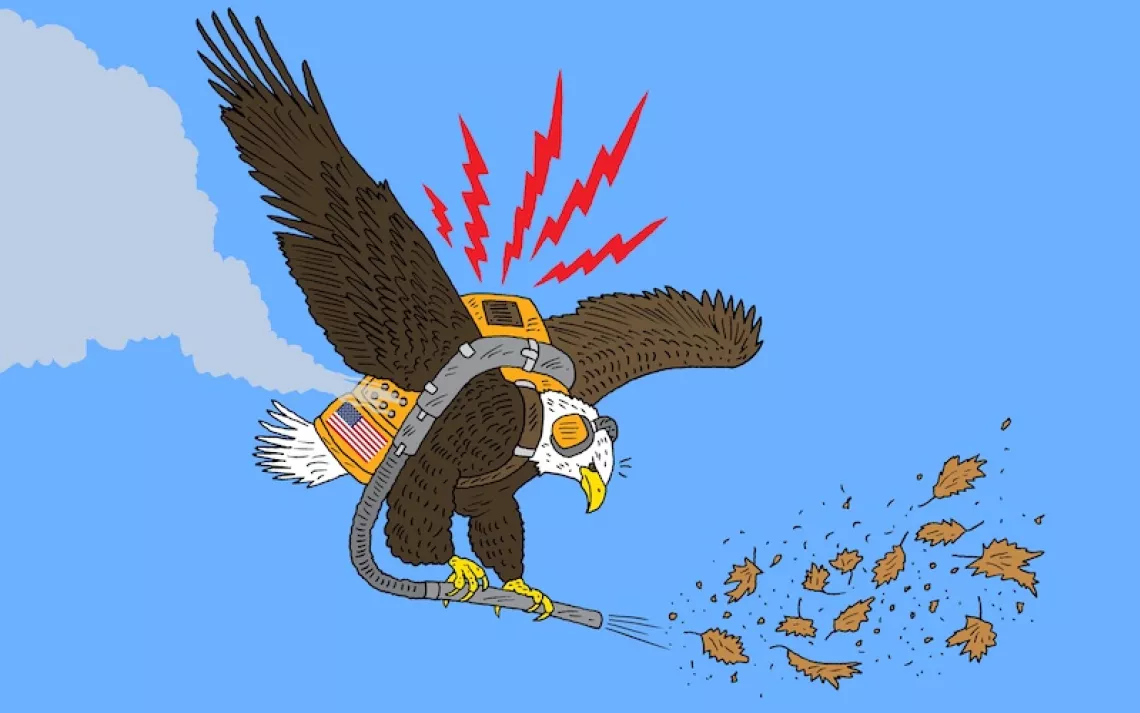If Not Prisoners, Who Will Fight the West’s Wildfires?
COVID-19 and criminal justice reform threaten the stock of firefighters

Steven Rose (left) with Jose Olmedo. Photo courtesy of the Ventura Training Center.
Steven Rose is stationed in Napa, wearing his blue firefighting uniform. He works in a Cal Fire office providing logistical support to a team of firefighters. After years of experience fighting fires across the state of California, he recently secured a full-time position with the state agency, working even when fire season isn’t raging.
A little over a year ago, his uniform looked a lot different: He was fighting fires in a bright-orange, prison-issue jumpsuit.
Rose was in and out of prison for years, but his most recent sentence began in 2016. His offense was relatively low-level, so they gave him a choice at the door: Go to Jamestown or Susanville and get trained as a wildland firefighter or risk being sent to another prison far from his family.
The choice was easy. He didn’t really want to work at a fire camp, but if he did, he’d get a reduced sentence and be able to live and work outside of prison walls. He didn’t think he’d ever get a job as a firefighter on the outside, but he was looking at a nine-year sentence, and he was eager to shorten it. He chose Jamestown.
Rose ended up serving only three years, paroling in 2019. He spent the whole time at the fire camp, fighting blazes during fire season and doing fuel reduction during the off-season. He worked in the office, too, supporting the crew. Then he got lucky: His lieutenant knew about a new program that had transformed Ventura Conservation Camp, a fire camp that housed prisoners in juvenile detention, into a new facility, the Ventura Training Center (VTC), on the cutting edge of wildland firefighting. It was the beginning of a new path for the parolee that would eventually put him on the front lines of the worst wildfire season in California history.
“I feel so much pride as a firefighter,” Rose said. “I just happen to have a different backstory.”
*
California has been using prison labor to fight fires since the 1940s, when World War II depleted much of the state’s stock of young men ready to be firefighters. But in the past few years, early-release programs have been steadily chipping away at the number of prisoners ready for the fire line. Those identified for early release tend to fit the profile for those eligible for fire crews: well-behaved, minimum-security prisoners. This has created a problem for the Golden State, with fewer firefighters and worse fire seasons.
The coronavirus exacerbated that problem. In August of last year, there were 2,772 incarcerated people housed at fire camps, according to a CDCR spokesperson. That number is down to 1,845 this year, as of September 14. To fill the gap, the state was forced to hire 858 seasonal and 172 permanent firefighters.
California isn’t the only state that relies on prison labor. Nearly every state in the American West—Arizona, Washington, Oregon, Idaho, Montana, Wyoming, Nevada, Colorado—has similar programs. As prison populations bloomed, so did a source of cheap labor. As climate change ratcheted fire season up, more labor was needed.
“We’re understanding how connected the prison system and the climate crisis are,” said Lindsey Feldman, a professor of anthropology at the University of Memphis. “We have to push really hard on making sure that we’re not relying on prison labor to save the state from burning down and then also make sure the state doesn’t burn down.”
Now, states are looking for a way forward.
In California, the Ventura Training Center is one of the pioneering programs trying to craft a prison-to-firefighting pipeline. Since 2018, the VTC has been housing and training parolees to fight fires, hoping to send former inmates into wildland firefighting roles. The program is jointly run by the California Department of Corrections and Rehabilitation, Cal Fire, California Conservation Corps, and a nonprofit called the Anti-Recidivism Coalition (ARC), which seeks to keep people from returning to prison. Cal Fire provides the fire chiefs, CDCR provides the parole officers, CCC helps administer programming, and the ARC provides life coaching and support with adjusting back to society.
Already, 29 men have gotten jobs at Cal Fire, with others securing positions at different fire agencies and in other industries.
Other states are creating similar programs. In 2017, Arizona governor Doug Ducey signed the Phoenix crew into existence, made of formerly incarcerated firefighters and envisioned as a way to reduce recidivism in the state.
Various neighboring states are now looking to replicate Arizona’s post-release program, said Tiffany Davila, a public affairs officer for the Arizona Department of Forestry and Fire Management. She said that Arizona is considering expanding the program to more crews, calling it “beneficial” for both the men and women involved and the state’s firefighting efforts.
*
It is notoriously difficult to get hired in firefighting with a criminal record. Municipal fire departments require applicants to have an EMT certification, which they can’t get if they’ve been convicted of a felony. Even men and women who participate in fire camps in prison, fighting wildfires every day, are not exempt from this rule.
But the rules are changing. On September 11, California governor Gavin Newsom signed a law, AB2147, seeking to solve that problem. The law clears the path for those prisoners who serve as firefighters while incarcerated to have their records cleared. With clean records, they would be free to get their EMT certification.
Even before this law, Steven Rose snagged a Cal Fire job. That’s because Cal Fire, along with most other state wildfire agencies, doesn’t require an EMT certification. But that doesn’t mean getting a Cal Fire job is easy. Many people released from prison are on parole and have strict travel restrictions that can get in the way of the requirements of a wildland firefighting job.
Besides, firefighting jobs are extremely competitive. According to Lynne Tolmachoff, a spokesperson with Cal Fire who was part of VTC’s original team, Cal Fire receives around 2,500 to 3,000 applications for seasonal firefighting jobs and only about 10 percent are accepted. Formerly incarcerated firefighters have to compete with applicants that have EMT certifications. That’s where VTC comes in: The center works to turn parolees into competitive applicants.
Rose paroled in 2019 and went straight to VTC. There, he learned to make a résumé for the first time in his life, well into his 30s. Life coaches there also helped him work through years of trauma from incarceration.
“VTC transformed my whole thought process,” Rose said. “I had this idea that I wanted to keep living clean and sober, but I didn't know how to do that yet. They showed me how.”
*
For Rose, working on a fire crew while in prison changed his life and secured him a job on the other side. But while he was incarcerated, he was still subject to the humiliation of being marked a prisoner.
“Everyone knows who wears orange. I still felt so much pride fighting fires, but everyone looked at me like I was a criminal,” Rose said. “It's a stigma. Not everyone in prison is a bad person.”
California’s prison firefighting program has come under fire in the past few years, as people object to prisoners working a dangerous job with little pay and no benefits. For a long time, prison firefighting was framed as a money-saving endeavor. California’s program, undoubtedly the largest, is estimated to save the state up to $100 million each year.
A CDCR spokesperson told NPR that prisoners on the fire line make $2.90 to $5.12 a day in California, depending on their skill level, with another $1 an hour if stationed on an active emergency. Despite this service, they often can’t get a job when they’re released. These new programs—and California’s new law—take a stab at the latter problem, but they entrench the first: In order to be eligible for a firefighting job or a chance at a clean record once they’re out, prisoners have to be fighting fires while incarcerated. Now, with many of California’s prison fire camps shut down because of COVID, some at VTC are concerned that there will be fewer eligible parolees because fewer prisoners will have had experience on fire camps.
“There is, in my opinion, no argument against the fact that prison labor broadly is exploitative,” said anthropology professor Lindsey Feldman. “But if we stop there, we’re missing something. And that something is that individuals placed in an oppressive system are capable of creatively making meaning in their lives.”
Feldman spent years studying incarcerated fire crews, getting trained as a wildland firefighter herself. When she was working with a fire crew in Arizona, according to Feldman, several other firefighters told her, “yeah, this is slavery.” They’d repeat the 13th amendment back to her. The public kicks up a lot of dirt every time prison firefighting is mentioned, but these men and women are living it—they know they’re being exploited.
Yet many volunteer.
Michelle Garcia, the program coordinator at the Anti-Recidivism Coalition, worked in a fire camp during the last two years of her incarceration. She pinpoints a particularly impactful moment: her first fire. It had started off the 101 freeway. She and her crew worked all night long. Walking through the forest, she lost track of where exactly she was until the sun came up. Then she saw it—the town where the victim of her crime lived.
“I just saved my victim’s community. I contributed to saving my victim,” Garcia said, feeling like she was giving back to the community she offended. “If only he knew.”
In her experience, fire camp saved her. It gave her purpose and meaning, which she has rediscovered through helping others re-enter free society after incarceration.
“If I would’ve just been paroled after the trauma I experienced at Chowchilla, I probably wouldn’t be alive,” she said. “I probably would’ve committed suicide.”
Michael Gebre, another VTC alum, said that prison fire camps were like a “pre-taste of freedom.” He was sentenced at 19 years old, and working in fire was his first real opportunity to change his life, he said. Now, he’s battling the Creek Fire in Fresno, recently hired as a seasonal firefighter for Cal Fire. He said serving his community feels “amazing.”
The attractiveness of prison fire programs—their relative freedoms, their less punitive environments—is a testament to the experience of many inside American prisons. When choosing between a prison cell and a megafire, many choose the flames.
*
Steven Rose said that clearing the felonies from his record will open up career opportunities. He can get an emergency medical license and wipe the stigma from his name. When he sees prison crews now, he tries to tell them that “there’s something after this.”
Rose has a second child on the way, and he’s determined to be there when his baby is born. He’s only been home for half of his 10-year-old daughter’s birthdays, and he doesn’t want to miss any more. Now, for the first time in his life, his family is calling him for help, not the other way around. His relative thanked him the other day, and he had no idea how to respond.
“You’re supposed to say ‘you’re welcome,’” they told him.
Even as legal barriers are reduced, the stigma of incarceration persists. Rose doesn’t tell everyone about his background. He said that, within his department, not everyone is OK with previously incarcerated people on the fire line.
“They don’t feel like former criminals should get that chance,” Rose said. “But people at VTC put their hard work in. Why wouldn’t you give them a chance?”
 The Magazine of The Sierra Club
The Magazine of The Sierra Club






